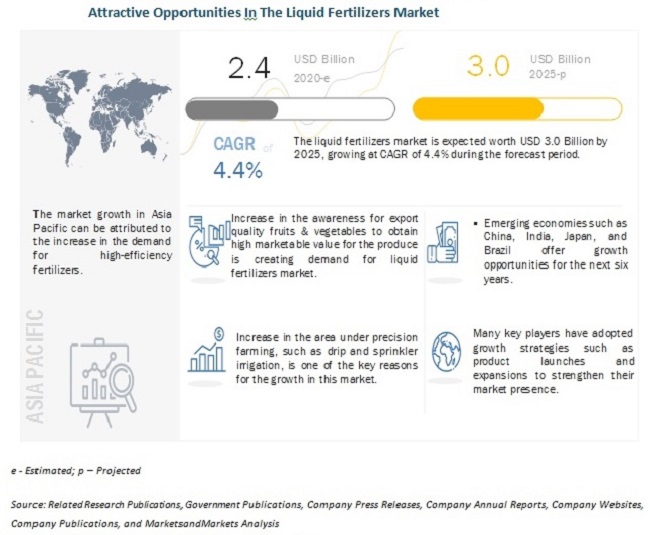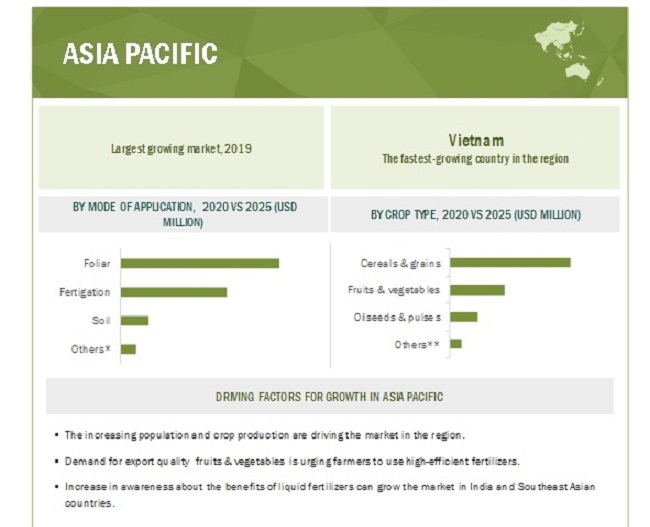
Exhibition time: 17-19 March, 2026 Shanghai, China
 中文
中文

Exhibition time: 17-19 March, 2026 Shanghai, China
 中文
中文
The global liquid fertilizers market size is estimated to be valued at USD 2.4 billion in 2020 and is projected to reach USD 3.0 billion by 2025, recording a CAGR of 4.4%. The increase in demand for enhanced high-efficiency fertilizers, ease of use and application of liquid fertilizers, and adoption of precision farming and protected agriculture are some of the factors that are projected to drive the growth of the liquid fertilizers market.

COVID-19 impact on Liquid fertilizers market
The liquid fertilizers market includes major Tier I and II suppliers like Nutrien, Ltd.(Canada), Yara International ASA (Norway), Israel Chemical Ltd. (Israel), K+S Aktiengesellschaft (Germany), Sociedad Química Y Minera De Chile (SQM) (Chile), The Mosaic Company (US), EuroChem Group (Switzerland). These suppliers have their manufacturing facilities spread across various countries across Asia Pacific, Europe, North America, South America, and RoW. The impact of COVID-19 has been minimal on the market as the companies had already sold the products ahead of the crisis. However, the import of major compounds from different countries has been delayed due to movement restrictions. Therefore, apart from mobility barriers, there is no significant impact on the prices of the products as such.
Liquid fertilizers Market Dynamics
Driver: Growth in demand for enhanced high-efficiency fertilizers
Enhanced, efficient application of liquid fertilizers ensures that crops and plants receive nutrients in an amount that is required at the right time and at the right place, with minimum wastage. Enhanced efficiency fertilizers (EEF) are growing substantially in the agriculture industry in various fields such as cereals and industrial crops, as a result of the emergence of new urease inhibitors and inexpensive polymer coating technologies. Such application of enhanced efficiency fertilizers also helps in reducing the negative impact of nutrients by way of leaching into water reservoirs.
Restraint: High handling costs
One of the major restraints in the growth of the liquid fertilizers market is the high storage cost of liquid fertilizers, along with the high cost of installation. Liquid fertilizers are water-soluble. The cost of mixing the nutrients in the water is high, and so is the cost of transportation, as fertilizers in the liquid form require distinctive handling and storage facilities. This is hindering the growth of the liquid fertilizers market around the globe, especially in regions such as Africa and the Middle East due to the lack of awareness about the application of liquid fertilizers.
Opportunity: New emerging economies
The increasing population in world has resulted in increasing demand for food, which will lead to further increase in the consumption of fertilizers. However, the major concerns in are the pollution and contamination of soil as well as their harmful effects on humans and the environment. To combat these harmful effects, governments are emphasizing on the use of fertilizers that are less harmful to the soil. Hence, there is an increase in the rate of awareness about liquid fertilizers among farmers, especially in China and India. Manufacturers, along with NGOs, educate farmers about their potential short-term and long-term benefits.
Challenge: Unfavorable regulatory standards
The fertilizer industry, like other industries, has its own share of regulatory and other state-level interventions, which propel and arrest its momentum. Policies unfavorable for the industry, including restrictions in terms of sourcing, production, and distribution norms; the end of subsidy support; the stipulation of the maximum retail price; and regulations concerning the quantum and direction of end use have a considerable impact on the overall industry.
Market Ecosystem

By crop type, the fruits & vegetables segment is projected to be the fastest-growing segment in the liquid fertilizers market during the forecast period.
The trend of consuming fruits has witnessed a growth in the past two decades, and this trend is projected to continue in the coming years. According to the FAO, China is the largest producer of fresh fruits and vegetables, which has surpassed the production and growth in the US and India in 2018. The increasing exports of fruits & vegetables have also led to an increase in the crop plantation area, which has resulted in a rise in their production levels. Hence, the crop protection chemicals market for fruits & vegetables is projected to witness significant growth. This, in turn, is projected to drive the liquid fertilizers market.
By type, the nitrogen segment is projected to dominate the liquid fertilizers market during the forecast period.
Nitrogen is one of the most-widely consumed nutrients among all the macro and microelements required for plant growth. It is used to build amino acids, which produce proteins, and take part in almost every biochemical reaction performed in a plant. Inadequate nitrogen (N) availability in the soil is a common problem that farmers often witness. Therefore, additional liquid nitrogen fertilization is required to eradicate this problem. Urea, ammonium nitrate, ammonium sulfate, and calcium nitrate are commonly available nutrient sources of liquid nitrogen. In addition, various combinations of nutrients are manufactured and used to provide nutrition to plants. Thus, the demand for liquid nitrogen fertilizers remains high globally.
By major compounds, the calcium ammonium nitrate (CAN) segment to be the fastest-growing segment in the liquid fertilizers market during the forecast period.
Calcium ammonium nitrate (CAN) is the most widely used nitrogen fertilizer due to its relatively high nutrient content and physical properties, such as high solubility, which helps in quickly dissolving into the soil. It contains calcium and magnesium, which help in improving the efficiency of absorbing nitrogen by the roots and reduce nitrogen losses, making the fertilization more profitable; this also protects subsoil waters against pollution by nitrogen compounds. CAN is used more in the case of acidic soils as it does not further acidify the soil. It is majorly used for wheat, barley, fruits, and vegetables. Increasing adoption of drip and sprinkler irrigation is projected to increase the demand for CAN fertilizers during the forecast period.
By mode of application, the fertigation segment is projected to be the fastest-growing segment in the liquid fertilizers market during the forecast period.
Fertigation is an agricultural technique, which includes water and fertilizer application through irrigation. This process provides an opportunity to maximize the yield and minimize environmental pollution. Moreover, through fertigation, a farmer can uniformly apply nutrients throughout the field, whenever required. This market is projected to grow due to the adoption of efficient irrigation systems globally.
The advantage of fertigation is that it requires less labor, time, energy, and water. This mode of application is gaining importance due to its reliability and efficacy. However, to get the desired results using this method, proper knowledge of the system and efficient management are required. Fertigation is used in fields of row crops, horticultural crops, fruit crops, vegetable crops, and ornamental & flowering crops. There has been a shift in farming practices toward holistic approaches that include both fertilizer and water application techniques, which is a key factor that is projected to drive the growth of this market in the next five years, particularly in North America and Europe.
The increasing demand for various crops in the Asia Pacific regions is driving the growth of the liquid fertilizers market.

The increasing agricultural practices and requirement of high-quality agricultural produce are factors that are projected to drive the nitrogenous fertilizers market growth in this region. Major crops produced in Asia include rice, sugar beet, fruits & vegetables, cereals, and grains; the region consumes 90% of the global rice produced. Asian countries, such as Korea, China, Japan, and recently Vietnam, are applying high levels of nitrogenous fertilizers per hectare, for both short-term and perennial crops. Hence, the demand for liquid fertilizers is high in the region.
Key Market Players
Key players in this market include Nutrien, Ltd. (Canada), Yara International ASA (Norway), Israel Chemical Ltd. (Israel), K+S Aktiengesellschaft (Germany), Sociedad Química y Minera de Chile (SQM) (Chile), The Mosaic Company (US), and EuroChem Group (Switzerland). These major players in this market are focusing on increasing their presence through expansions & investments, mergers & acquisitions, partnerships, joint ventures, and agreements. These companies have a strong presence in North America, Asia Pacific, and Europe. They also have manufacturing facilities, along with strong distribution networks across these regions.
From Markets and Markets
